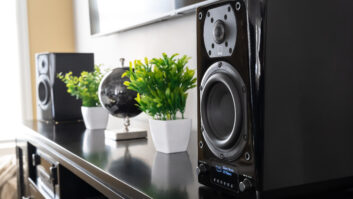There are so many variables at hand when selecting speaker placement in general, it’s even more of a delicate dance to find that subwoofer sweet spot. Much of acoustical research focuses on placing subwoofers for that one, single spot, but in reality, you’re designing a room where multiple people want to enjoy hi-fi sound without sitting on top of each other.

This diagram from Appendix A in the “CEA/CEDIA CEB22: Home Theater Recommended Practices: Audio Design” guide depicts one of the six best subwoofer configurations for a rectangular room where exact dimensions are not known. This particular layout produces the lowest seat-to-seat variance in the seating area.
Bigger is NOT Better. It is more effective to use multiple, smaller subwoofers instead of one large one to increase coverage consistency. In fact, cross placing four subwoofers has become a more common practice as initiated by significant research from Harman. Using the four-subwoofer setup, a room’s standing-wave resonances can become neutral. To really capitalize on some of the intense bass many movie soundtracks feature, you may find as many as eight subwoofers fit within your room calculations. Harman’s research actually demonstrated that using 5,000 subwoofers in a test room virtually eliminated modal variation; although, the research concludes that this approach is theoretical and not practical.
“Rule-of-Thumb” Placement. Harman research acoustician Todd Welti has written that rule-of-thumb subwoofer placement, based on axial modes, is useful; however, the results are not often intuitive due to tangential modes, in-between modes, and frequency response complexity. There’s a lot of theory in subwoofer placement, which is important to understand, but the reality can dictate different terms.

Velodyne’s DD-18+
Calculating metrics provides a more accurate rendering of a room’s acoustics in most cases, and there are various software tools available to use. These include CARA, Room Optimizer, and JBL’s ARCOS system, which v3.0 released at CEDIA this year includes fluid dynamic low-frequency optimization (FLO) standard analysis/design.
Welti’s research investigated the most practical subwoofer placements in a real test room. He concluded, “When you consider the additional expense of using more subwoofers, there is certainly no justification for using more than four. To the contrary, it was observed that the [low-frequency] factor actually went down for larger numbers of subwoofers.” He continued, “If cost and aesthetics are considered, subwoofers at two wall midpoints is preferred.”
No Two Rooms are the Same. The reality is that you’re dealing with different dimensions in most every home theater or media room you install, so it’s important to do your own tests and calculations with consideration given to external factors, like construction material and other equipment or furniture in the room. With smaller rooms, you may need to isolate sound or otherwise compensate for wavelengths that exceed the length of the room, which results in waves rebounding from a wall and combining with subsequent waves that sum or cancel, as well as creating low-frequency nodes and nulls. Bass trapping is one method of absorbing long wavelengths. Employing limiters is another way to prevent distortion–although they can be confusing when trying to measure the maximum subwoofer output level.
Lindsey Adler is assistant editor for Residential Systems and Systems Contractor News.




